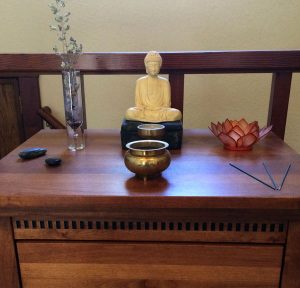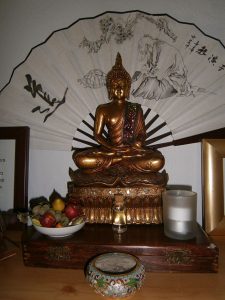Relationships and situations at home and at work offer daily opportunities for mindfulness and practice of the Precepts. With the Precepts as our guide for expression, intention, and purpose, we can simply look, acknowledge that which arises, and relinquish our grasping it as it passes away. Coming to see Buddha Nature in all that is, in what and who we like and don’t like; learning to see with a compassionate eye and an open heart are some of the fruits of lay training in daily life. Every-minute Meditation by Reverend Master Daizui MacPhillamy addresses how we bring our meditation practice to all aspects of our daily life.
The following talks by Reverend Master Kodo Kay provide practical suggestions for deepening one’s training in our families, relationships, work and professional life, and in the ways we relax and enjoy ourselves.
Reverend Master Kodo Kay – The Offering of Lay Training Retreat
Welcoming Tea and Introduction 43 min/17MB
Taking Refuge 59 min/19MB
Cease From Evil 54 min/21MB
Thanks to Achalanatha 48 min/15MB

HOME ALTARS
Home altars serve as a point of focus for one’s daily practice. Whether in a separate meditation room or on a bookshelf in the bedroom, the altar is an invitation to bow and a reminder that our practice is a deeply meaningful part of our lives. Home altars typically include a statue or an image of the Buddha or of a Bodhisattva – Kanzeon(the Bodhisattva of Compassion), Jizo (the Bodhisattva who protects the weak and the vulnerable), Manjusri (the Bodhisattva of Wisdom), Maitreya (the Buddha yet to come) – as well as a candle or light, flowers, incense (and somewhere to place the lit incense), and an offering cup of water. These items may be as simple as one’s means allow.
The statue or the image should be the central figure on the altar. The water cup is placed before the statue and symbolizes the cleansing aspect of the Eternal. The candle or light symbolizes the Light of the Dharma and is usually placed on the right side of the altar. The flowers – most often artificial – are placed on the right side. It is an important part of one’s practice to keep the altar clean and dust free, as well as to have fresh water and incense. Having a home altar is one means of “bringing the practice home”. bolize the joy of training as well as the blossoming of Enlightenment. They are usually placed on the left side of the altar. The incense is the traditional offering at an altar and represents one’s offerings of gratitude, as well as one’s intentions and aspiration. Your Place of Meditation by Rev. Master Shiko Rom describes in greater detail the elements of a home altar and its uses.
CHILDREN AND FAMILIES
According to tradition, the Buddha was 7 years old when he had his first experience of meditation. Children have an intuitive inclination to sit quietly, and this is something that parents and children can do together in front of the home altar. Rev. Master Jiyu-Kennett reflected on children and families in her article Children and Meditation.
EXPRESSIONS OF GENEROSITYThe spirit of dana flows throughout the practice of Serene Reflection Meditation. Offerings to and from the the Priory and the lay Sangha teach not only the spirit of generosity, but open the heart to both the giving and receiving of the teachings. There are also many opportunities to contribute expertise in completing special projects and with ongoing needs of the Priory. Offerings of food and the necessities of daily life are most welcome. And financial contributions, particularly those offered on a regular basis, are most gratefully accepted.
